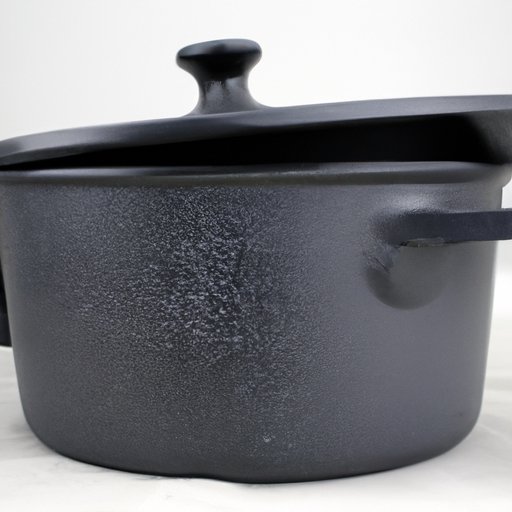Introduction
Dutch ovens are versatile, time-tested kitchen tools that have been a staple for chefs, home cooks, and adventurers for centuries. A Dutch oven is a type of pot or kettle made from heavy cast iron, featuring a tight-fitting lid, and often used for one-pot cooking. With the ability to sear, braise, bake, and stew, it’s no surprise that the Dutch oven has become an essential part of many kitchens. This article will explore the basics of Dutch oven cooking, its historical background, tips to maximize its use, how to choose the right model, and more.
The Basics of Dutch Oven Cooking: How Does It Work?
The science behind Dutch oven cooking is simple yet crucial for successful results. The heavy cast iron used for Dutch ovens retains heat well and distributes it evenly throughout the pot. As a result, the food is cooked evenly without hotspots or burning. The tight-fitting lid also traps moisture and flavor, resulting in tender, flavorful dishes. One of the benefits of using a Dutch oven is that it can go from stovetop to oven with ease, making it perfect for one-pot meals like stews, soups, and casseroles.
To make the most out of your Dutch oven, there are a few general tips to keep in mind. Always preheat your oven or stovetop to the appropriate temperature before adding your Dutch oven. Plan ahead- Dutch oven cooking can be a bit of a time investment, but the result is always worth it. And finally, when it comes to selecting the size of your Dutch oven, keep in mind that it should fit the food you’re cooking but leave enough room for air circulation.
Dutch Ovens: A Historical Perspective on a Timeless Tool
The Dutch oven has a long and storied history dating back to the 1600s, when they were developed in the Netherlands. The Dutch oven was brought to America by early settlers and was used extensively by cowboys in the American West. Dutch ovens have evolved since then and have become an essential tool for chefs and home cooks alike, with different variations such as enameled Dutch ovens now available. A Dutch oven’s durability and versatility, combined with its historical significance, make it a valuable addition to any cook’s kitchen arsenal.
Maximizing Your Dutch Oven: Tips and Tricks for Better Results
Using a Dutch oven effectively requires a bit of finesse, but with the right techniques, it can be an incredibly rewarding experience. Choosing the right Dutch oven can be overwhelming, but generally, enameled Dutch ovens are easier to clean and don’t require seasoning. Non-enameled Dutch ovens are great for campfire cooking and can reach higher temperatures. Depending on how you plan to use your Dutch oven, either model can work for you.
Seasoning your Dutch oven is crucial to keep it in good condition. To season your Dutch oven, coat the inside with a thin layer of oil, place it in the oven at 350°F for an hour, and let it cool before wiping any excess oil. When cooking with your Dutch oven, searing meat before braising it can add depth of flavor. Placing a bed of vegetables or parchment paper can prevent burnt food and make cleanup easier. Lastly, cleaning and maintaining your Dutch oven is simple as long as you avoid soap and always ensure it’s dried completely before storing.
One-Pot Wonders: Exploring the Versatility of Dutch Ovens
The possibilities of what you can cook with a Dutch oven are virtually endless. You can make soups, stews, casseroles, and much more. Dutch ovens are even great for baking bread, cakes, and other desserts! They are especially useful for one-pot meals where you can brown meat and sauté vegetables on the stovetop, then transfer your Dutch oven directly into the oven for a slow-cooked, flavorful meal. With its impressive versatility, it’s no wonder that Dutch ovens are a favorite among home cooks and chefs alike.
Dutch Oven Showdown: Comparing and Contrasting Different Models
Dutch ovens come in various models, and it’s crucial to know their strengths and weaknesses to choose the right one for your needs. Enameled Dutch ovens are easier to clean and don’t require seasoning. They’re great for cooking acidic foods such as tomatoes and can be used for baking. Non-enameled Dutch ovens are more affordable and can reach higher temperatures, making them perfect for campfire cooking. Additionally, some non-enameled Dutch ovens come preseasoned and ready to use. The size of a Dutch oven is also essential, and it should fit the food you’re cooking but still allow some air circulation. Ultimately, the right Dutch oven is the one that best suits your needs and budget.
Conclusion
The Dutch oven is a valuable kitchen asset that can last a lifetime with proper care and use. From one-pot meals to bread and desserts, the versatility and range of possibilities make it a kitchen staple worth having. Regardless of whether you’re a seasoned home cook or just starting, the Dutch oven’s unique features should make it a top contender for your next kitchen purchase.
(Note: Is this article not meeting your expectations? Do you have knowledge or insights to share? Unlock new opportunities and expand your reach by joining our authors team. Click Registration to join us and share your expertise with our readers.)
